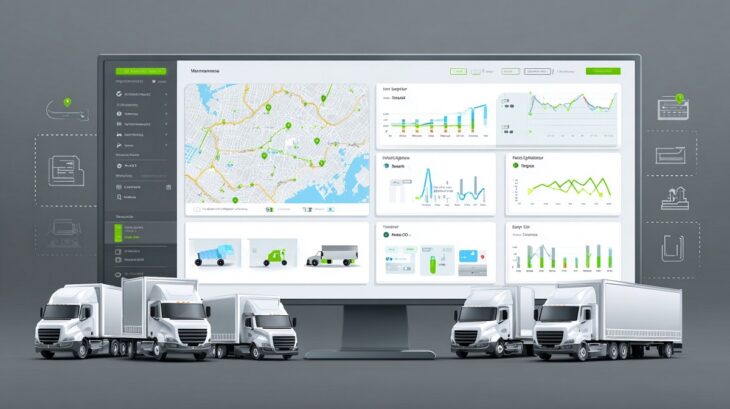Ever paused and thought, managing a fleet can feel like juggling flaming torches while riding a unicycle? You’re trying to keep tabs on every vehicle’s whereabouts, optimize fuel usage, ensure driver safety, all while staying sane.
But real-time fleet-tracking software has become downright essential for smoothing out those frenzied edges. Cool GPS tech, telematics gadgets, and data analytics have come together to give businesses a window into their fleet operations that once only lived in sci-fi.
With 2025 well underway, tools have leapt forward – AI and integrations make them both smarter and smoother, whether you’re handling a mini delivery team or a giant construction fleet.
So, wondering what steps to take next? I’ll walk you through the ten standout platforms today, laying out what they each do best, how much they cost, and how real businesses benefited.
All of that to help you figure out which one syncs best with your operation.
Table of Contents
Toggle1. Verizon Connect

Fresh location updates every 30 seconds. Dashboard with efficiency metrics, compliance tracking, AI-powered dash cams, fuel card hooks, and predictive maintenance alerts.
Pairing with quality components like the ones from Hubtrac tyres can further extend vehicle uptime.
- Big pluses: lightning-fast refresh, robust reporting, clean interface.
- Trade-offs: not the cheapest, often a three-year contract.
- Pricing ballpark: ~$23.50/month per vehicle, hardware about $150/device.
- Score: ~3.5/5 in Forbes.
A logistics operator trimmed fuel waste by 10% through sharper routing. Real-life value right there.
2. Samsara
AI that analyzes routes and offers driver coaching in real-time. Updates every 30-60 seconds plus predictive maintenance tracking. AI dash cams, fuel tracking, 360-degree cams.
- Upside: strong for vehicle oversight, round-the-clock support, and AI tools.
- Downsides: three-year contracts, steeper start cost.
- Price: $27-$33/month per vehicle, hardware $99-$148.
- Ratings: 4.4/5 (Forbes), 4.6/5 (G2).
A transportation outfit cut accidents by 15%. Proof that safety really pays.
3. Geotab
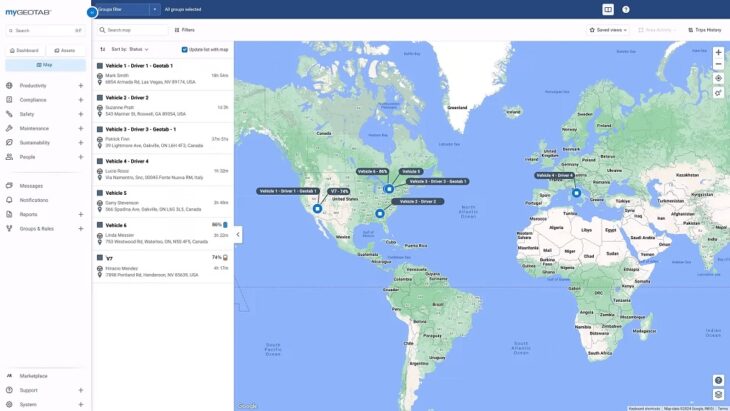
Big global platform with GPS, health diagnostics, fuel tracking, custom reports, in-vehicle coaching, and solutions tailored to industries like construction.
- Pros: flexible, advanced AI, top-notch security.
- Cons: reporting setup can be finicky, occasional login fuss.
- Pricing: custom quotes, roughly $25/month expected.
- G2 partnership rating: 8.6 (very strong).
Utilities firm boosted fleet efficiency 20% – predictive analytics cut downtime.
4. Motive
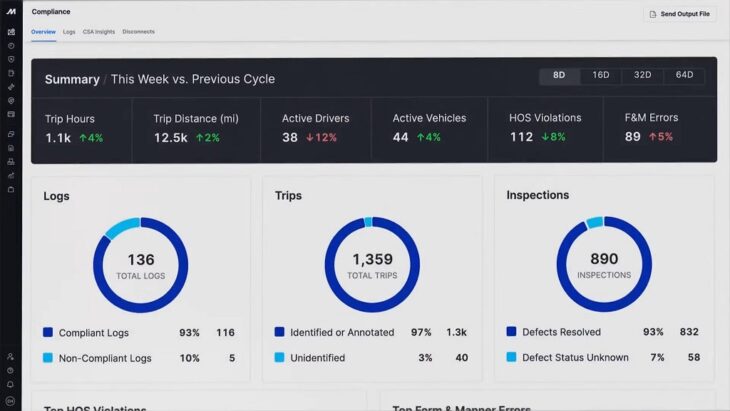
Live GPS, driver scoring, ELD compliance – all with simple hardware install. Also includes dispatch, maintenance tracking, and AI load boards.
- Highlights: tons of features, demos available, automated telematics.
- Downsides: pricing not easy to find, some billing confusion.
- Estimate: around $25/month per vehicle plus $150 per ELD.
- Ratings: 4.8/5 (Forbes), 4.5/5 (G2).
A courier service improved response time 25% thanks to real-time alerts.
5. Fleetio
Maintenance paired with tracking. Mobile-app location tracking, health data via diagnostics, engines, odometer, plus driver leaderboards and report-making.
- Pros: effortless data entry, simple pricing, and mobile-friendly.
- Cons: reporting stays basic, and the interface can feel cluttered.
- Cost: starts at $3/month per vehicle.
- Scores: 4.5/5 on PCMag, 4.5/5 on G2.
An environmental services company centralized vehicle records, dropping maintenance guesswork entirely.
6. Azuga
Offers 30-second updates, safety cams, driver scoring, fuel integration, maintenance alerts, and even a rewards program.
- Pros: affordable, GPS tracker included, incentives for drivers.
- Cons: occasional lag, cameras cost extra.
- Pricing: $25-$35/month.
- Ratings: 4.8/5 (Forbes), 4.7/5 (G2).
One fleet operator lifted safety scores 18% by recognizing top drivers and reducing incidents.
7. Teletrac Navman
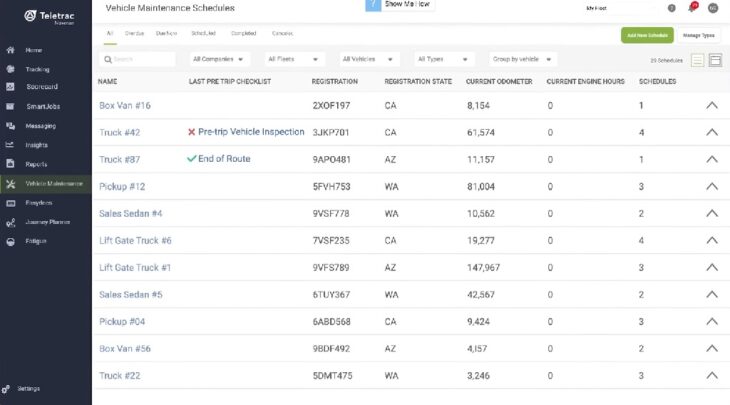
Focus on driver behaviour. Real-time alerts for speeding, geo-fences, plus job dispatching and performance scoring.
- Pros: strong driver monitoring, polished reports.
- Cons: short warranty, lacks some newer features.
- Price: ~ $25/month per vehicle.
- Rating: 4.0/5 on PCMag.
In the construction space, 360-degree cameras cut accidents by 12%, especially in blind spots.
8. Linxup
Super-simple tracking for small fleets or assets. Real-time location and speed, plus asset tracking for non-vehicles.
- Benefits: affordable, durable hardware.
- Limitations: limited advanced features.
- Pricing: $25/month per vehicle.
- Score: 4.2/5 Forbes.
Heavy-equipment users added solar-powered trackers – saved thousands by stopping loss.
9. GPS Insight
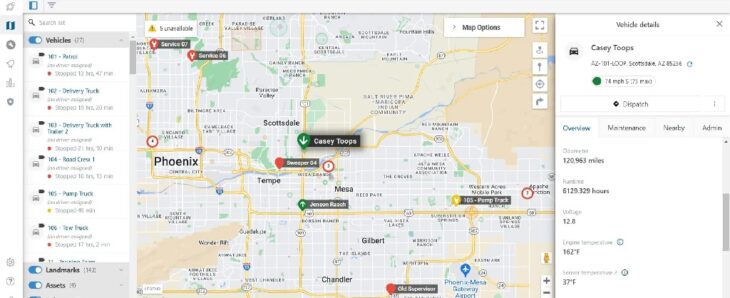
Shorter contracts fit better with fluctuating fleets. Real-time ETAs, AI dash cams, custom integrations, alerts, report builder.
- Pros: flexible terms, easy platform.
- Cons: minimum fleet size of about 10 vehicles.
- Cost: varies (custom quote).
- Rating: 4.5/5 on Forbes.
Service trades saw customer trust grow 22% by nailing ETAs.
10. Lytx
Strong video focus – dashcams record driver events, AI tags risks in real-time.
- Advantages: video brings huge safety insight, user-friendly.
- Downsides: no cost control tools, pricing not clear.
- Pricing: custom.
- Ratings: 4.0/5 (PCMag), 4.4/5 (G2).
Fleets reported a 30% drop in risky driving behaviours – video accountability is powerful.
What Fleet Management Software Really Does
Let’s say you’ve heard about fleet software but lack the nitty-gritty. Picture hardware – GPS units, dash cams, ELDs – hooking into every vehicle, streaming data to the cloud.
That data becomes dynamic insights: vehicle location, speed, engine health, idling, driver behaviour, route progress, fuel use – all live. One alert can flag route deviation, another warns of speeding, or low battery, or maintenance due.
Suddenly you’re not reacting – you’re guiding, optimizing, keeping things smooth. Here’s an everyday scene: a delivery firm sees a driver stuck in traffic. A real-time alert pops up.
The manager shifts the route on the fly. Driver pivots, makes the delivery on time – the client stays happy. That’s what active oversight delivers. Fleet gets organized. Safety improves. Productivity climbs. That’s the payoff.
Comparison Table at a Glance
Here’s a quick visual summary to compare key features, cost, and ratings:
| Tool | Real-Time Highlights | Pricing (per vehicle/month) | Avg. Rating |
| Verizon Connect | 30-sec updates, AI dashcams | ~$23.50, hardware ~$150 | ~3.5 / 5 |
| Samsara | AI routing, 30-60 sec updates | $27-$33, hardware $99-$148 | ~4.5 / 5 |
| Geotab | Analytics, engine health | Custom (~$25) | ~4.6 / 5 |
| Motive | GPS, driver scoring, ELD | ~$25 + hardware ~$150 | ~4.7 / 5 |
| Fleetio | Mobile tracking, leaderboards | Starts at $3 | ~4.5 / 5 |
| Azuga | Safety cams, rewards, 30-sec updates | $25-$35 | ~4.8 / 5 |
| Teletrac Navman | Alerts, performance scoring | ~$25 | ~4.0 / 5 |
| Linxup | Basic GPS, asset tracking | ~$25 | ~4.2 / 5 |
| GPS Insight | ETAs, AI cams, flexible contracts | Custom | ~4.5 / 5 |
| Lytx | Video capture, event detection | Custom | ~4.2 / 5 |
Picking the Right Tool
Let’s keep this grounded – what goes into choosing a tool? Here’s a short checklist, written plainly:
- Fleet size and stretch – A small 5-vehicle team has different needs than 200 rigs.
- Budget and pricing structure – Monthly per-vehicle fees often range $20-$40, but don’t forget hardware costs and contract terms.
- Real-time depth – How often does the platform update? 30 seconds? 60 seconds? What about AI-based insights?
- Integration power – Can it sync with your fuel cards, maintenance system, CRM, payroll, anything you already use?
- UX and support – Is the interface easy to use? Can you lean on customer support when needed?
- Reputation – Look at platforms rated above 4.5 stars on G2, Forbes, PCMag – solid feedback beats hype.
What’s Ahead for Fleet Tracking in 2025 and Onward
Let’s take a quick peek at what’s just over the hill:
- AI-powered predictive maintenance – tools suggesting service before something breaks.
- EV support – real-time battery tracking, charge-cycle analytics, smart routing to chargers.
- Sustainability tracking – monitoring carbon emissions, eco-scoring drivers, green routing suggestions. These growth areas don’t just improve your fleet – they help future-proof operations as industries pivot greener.
Final Thoughts
So, what’s the biggest takeaway? Real-time fleet-tracking tools have moved way past basic GPS. They’re now about safety, efficiency, maintenance, and even driver motivation, with powerful AI and integrations making them smarter than ever.
Start by taking stock of what your fleet struggles with: fuel use, accidents, delayed maintenance, lost equipment, and poor customer communication. Take advantage of free demos or trial periods, and feel how a platform fits your rhythm.
Each tool on this list offers something special, whether it’s AI coaching that nudges safer driving or a video that helps cut risky behaviours. Pick what syncs with your team’s style and needs, and you’ll discover real gains for operations, cost, and team morale.
